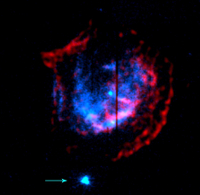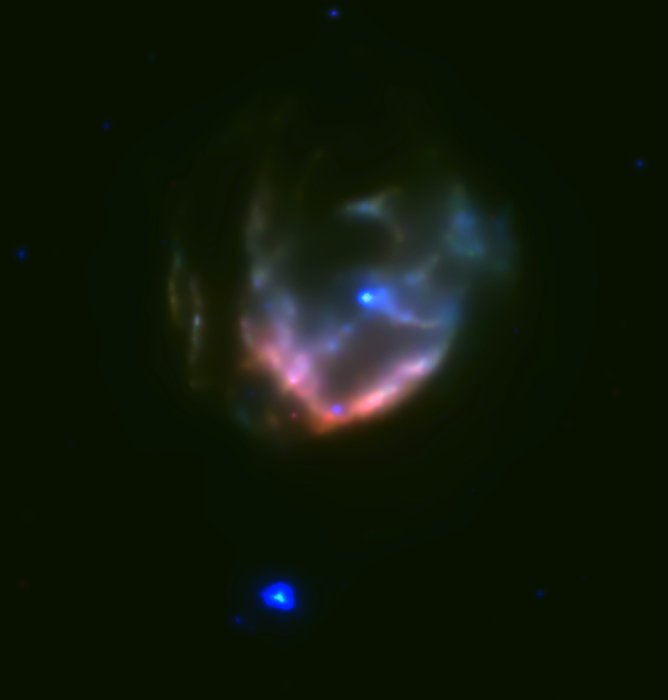Find out the latest thinking about our universe.
-
bystander
- Apathetic Retiree
- Posts: 21577
- Joined: Mon Aug 28, 2006 2:06 pm
- Location: Oklahoma
Post
by bystander » Mon Apr 28, 2014 4:59 pm
 HEAPOW: New Supermagnet (2014 Apr 28)
HEAPOW: New Supermagnet (2014 Apr 28)
As a massive star forms an
iron core and dies, the core, as it collapses under its immense weight, concentrates its magnetic field and spins faster and faster, conserving angular momentum like a
figure skater. The remnant core (if not too massive) will form a rapidly-spinning, highly magnetized neutron star. A small fraction of these newborn neutron stars have extraordinarily strong magnetic fields, millions of billions of times stronger than the magnetic field of the Sun (or hundred-trillion refrigerator magnets). These neutron stars are called
magnetars. Magnetars spin rapidly (rotating once every 10 seconds or less) and this rapid rotation enhances the magnetic field. The magnetar's intense magnetic fields can generate intense bursts of X-rays and Gamma-rays. In fact, magnetars were first discovered as so-called
Soft Gamma-ray Repeaters, or SGRs. Only about
two dozen magnetars are known. The image above (a composite X-ray image from the
XMM-Newton X-ray Observatory and a radio image in red from the
VLA) shows the appearance of a bright source of X-rays (shown by the arrow) near a supernova remant called
Kes 79. Astronomers have identified this source as a new magnetar, and estimate that the distance to the magnetar is about the same as the distance to the supernova remnant, which suggests that the magnetar is associated with the supernova remnant. While supernovae can produce both neutron stars and supernova remnants, Kes 79 already has a neutron star sitting at its center (as seen above). One explanation is that the star that exploded to form Kes 79 was a binary system in which an earlier explosion of the more massive component left a
high-mass X-ray binary consisting of a magnetar orbiting a normal star. The supernova explosion of the second star could then have produced Kes 79 and thrown the magnetar out into space.
ESA: XMM-Newton discovers transient magnetar
COSPAR: Rare Magnetar Discovered
Discovery of the transient magnetar 3XMM J185246.6+003317 near supernova remnant Kesteven 79 with XMM-Newton - Ping Zhou
et al
Know the quiet place within your heart and touch the rainbow of possibility; be
alive to the gentle breeze of communication, and please stop being such a jerk. — Garrison Keillor
-
geckzilla
- Ocular Digitator
- Posts: 9180
- Joined: Wed Sep 12, 2007 12:42 pm
- Location: Modesto, CA
-
Contact:
Post
by geckzilla » Mon Apr 28, 2014 5:27 pm
Which thing is Kes 79 and which is Kes 73?
Just call me "geck" because "zilla" is like a last name.
-
bystander
- Apathetic Retiree
- Posts: 21577
- Joined: Mon Aug 28, 2006 2:06 pm
- Location: Oklahoma
Post
by bystander » Mon Apr 28, 2014 5:46 pm
Good question. Let's see if Dr. Corcoran can answer it. Posted it to the
HEAPOW facebook group.
Know the quiet place within your heart and touch the rainbow of possibility; be
alive to the gentle breeze of communication, and please stop being such a jerk. — Garrison Keillor
-
Beyond
- 500 Gigaderps
- Posts: 6889
- Joined: Tue Aug 04, 2009 11:09 am
- Location: BEYONDER LAND
Post
by Beyond » Mon Apr 28, 2014 5:56 pm
So Kes 79 (the magnetar), came before Kes 73 (the supernova remnant). So that which was actually first, was noticed second, because it was easier to see a supernova remnant through a telescope, then a magnetar. Interesting to me that the magnetar looks like a perfect little blue heart, or is that just a depiction of where it is, but we can't really see it??
To find the Truth, you must go Beyond.
-
geckzilla
- Ocular Digitator
- Posts: 9180
- Joined: Wed Sep 12, 2007 12:42 pm
- Location: Modesto, CA
-
Contact:
Post
by geckzilla » Mon Apr 28, 2014 6:03 pm
The magnetar is 3XMM J185246.6+003317. I'm leaning toward all instances of Kes 73 being typos, odd as it seems to have all but one of them be wrong.
Just call me "geck" because "zilla" is like a last name.
-
Chris Peterson
- Abominable Snowman
- Posts: 18190
- Joined: Wed Jan 31, 2007 11:13 pm
- Location: Guffey, Colorado, USA
-
Contact:
Post
by Chris Peterson » Mon Apr 28, 2014 8:52 pm
geckzilla wrote:The magnetar is 3XMM J185246.6+003317. I'm leaning toward all instances of Kes 73 being typos, odd as it seems to have all but one of them be wrong.
Kes 73 is 6.2° away from Kes 79, and the FOV of the above image is only 0.25°. And the paper only references Kes 79.
-
bystander
- Apathetic Retiree
- Posts: 21577
- Joined: Mon Aug 28, 2006 2:06 pm
- Location: Oklahoma
Post
by bystander » Tue Apr 29, 2014 2:21 pm
geckzilla wrote:I'm leaning toward all instances of Kes 73 being typos
That is indeed the case. It has now been fixed.
Know the quiet place within your heart and touch the rainbow of possibility; be
alive to the gentle breeze of communication, and please stop being such a jerk. — Garrison Keillor
-
MargaritaMc
- Look to the Evenstar
- Posts: 1836
- Joined: Wed Jan 09, 2013 10:14 pm
- Location: 28°16'7"N 16°36'20"W
Post
by MargaritaMc » Mon Sep 01, 2014 1:25 pm
ESA - Space in Images.
Title: Magnetar discovered close to supernova remnant Kesteven 79
Released: 01/09/2014 9:54 am
Copyright: ESA/XMM-Newton/ Ping Zhou, Nanjing University, China
Neutron stars come in several flavours, depending on properties such as their ages, the strength of the magnetic field concealed beneath their surface, or the presence of other stars nearby. Some of the energetic processes taking place around neutron stars can be explored with X-ray telescopes, like ESA's XMM-Newton.
This image depicts two very different neutron stars that were observed in the same patch of the sky with XMM-Newton. The green and pink bubble dominating the image is Kesteven 79, the remnant of a supernova explosion located about 23,000 light-years away from us.
... The explosion left behind a a young neutron star with a weak magnetic field, which can be seen as the blue spot at the centre of Kesteven 79.
Beneath it, a blue splotch indicates an entirely different beast: a neutron star boasting an extremely strong magnetic field, known as a magnetar. Astronomers discovered this magnetar, named 3XMM J185246.6+003317, in 2013 ...
This false-colour image is a composite of 15 observations performed between 2004 and 2009 with the EPIC MOS camera on board XMM-Newton. The image combines data collected at energies from 0.3 to 1.2 keV (shown in red), 1.2 to 2 keV (shown in green) and 2 to 7 keV (shown in blue).
more at http://www.esa.int/spaceinimages/Images ... esteven_79
Margarita
"In those rare moments of total quiet with a dark sky, I again feel the awe that struck me as a child. The feeling is utterly overwhelming as my mind races out across the stars. I feel peaceful and serene."
— Dr Debra M. Elmegreen, Fellow of the AAAS
 HEAPOW: New Supermagnet (2014 Apr 28)
HEAPOW: New Supermagnet (2014 Apr 28)
